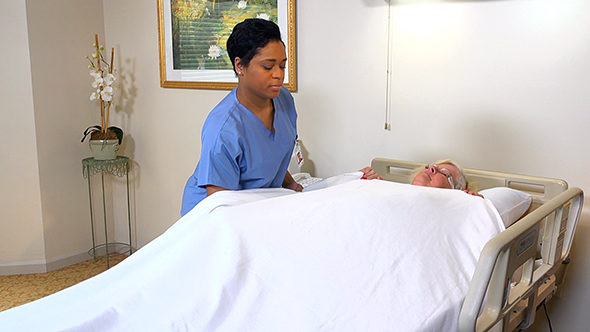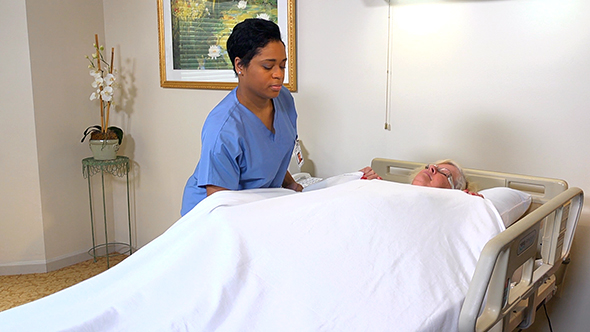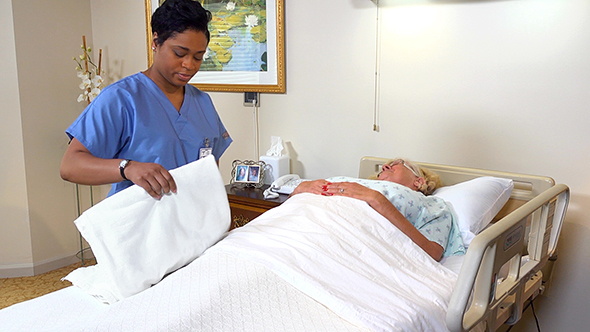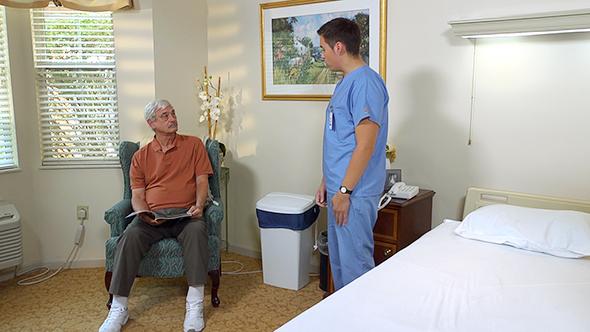Personal Hygiene and Grooming
Select a Skill:
- » Performing Oral Hygiene
- » Providing Denture Care
- » Brushing and Combing the Person's Hair
- » Shampooing the Person's Hair
- » Shaving the Person's Face
- » Giving Nail and Foot Care
- » Assisting with Undressing and Dressing
- » Changing the Gown of the Person with an IV
Take the Review Test:

Purpose

- Most residents wear street clothes during the day and sleepwear at bedtime. Most patients wear gowns. Gowns are changed daily. Garments are also changed after bathing, on admission and discharge, and when wet or soiled.
- Some patients and residents dress and undress themselves. Others need help.
- When you assist with dressing and undressing, follow these rules:
- Provide privacy. Do not expose the person.
- Encourage the person to do as much as possible.
- Let the person choose what to wear. Personal choice is a resident right. Make sure the person chooses the right undergarments.
- Make sure garments and footwear are the correct size.
- Remove clothing from the strong or “good” (unaffected) side first.
- Put clothing on the weak (affected) side first.
- Support the arm or leg when removing or putting on a garment.
- Move and handle the body gently. Do not force a joint beyond its range of motion or to the point of pain.
Equipment
Roll cursor over items to see labels. For the purposes of clearly depicting the equipment, a barrier is not shown in this photo. When providing care, a barrier should always be placed on the surface before placing the equipment.

Bath blanket
Slippers, Socks, Pullover shirt, Pants
Delegation
- Follow delegation guidelines. Before assisting with undressing and dressing, obtain this information from the nurse and care plan:
- How much help the person needs
- Which side is the person’s strong side
- If the person needs to wear certain garments
- What observations to report and record
- When to report observations
- What patient or resident concerns to report at once
Preparation

- Observe quality-of-life measures.
- Review the information under Delegation and Safety and Comfort.
- Ask a co-worker to help turn and position the person if needed.
- Practice hand hygiene.
- Collect the bath blanket and clothing requested by the person.
- Identify the person. Check the ID bracelet against the assignment sheet. Also call the person by name.
- Provide for privacy.
- Raise the bed for body mechanics. Bed rails are up if used.
- Lower the bed rail on the person’s weak side.
- Position him or her supine.
- Cover the person with a bath blanket. Fan-fold linens to the foot of the bed.
Safety

- When assisting with dressing and undressing, you turn the person from side to side. To protect the person from falling, take these steps:
- If the person uses bed rails, raise the far bed rail.
- If bed rails are not used, ask a co-worker to help turn and position the person.
Comfort
- This skill does not include comfort content.
Procedure Video
Audio Description: OFFFollow-up Care

- Provide for comfort.
- Place the call light within reach.
- Lower the bed to the low position. Raise or lower bed rails. Follow the care plan.
- Unscreen the person.
- Complete a safety check of the room.
- Follow agency policy for soiled clothing.
- Practice hand hygiene.
Reporting/Recording
- Report and record your observations, including:
- How much help was given
- How the person tolerated the procedure
- Any complaints by the person
- Any changes in the person’s behavior
Review Questions
Select the best answer.
1. When assisting with dressing and undressing, what rule should you follow?
 Put clothing on the strong (unaffected) side first.
Put clothing on the strong (unaffected) side first. Remove clothing from the weak (affected) side first.
Remove clothing from the weak (affected) side first. Support the arm or leg when dressing or undressing.
Support the arm or leg when dressing or undressing. Dress the person in a hospital gown for easier clothing changes.
Dress the person in a hospital gown for easier clothing changes.
Select the best answer.
2. What is the correct procedure for helping a person dress in a pullover shirt?
 Gently pull the garment over the person’s head, adjust the neck opening, and insert both arms into the sleeves at the same time.
Gently pull the garment over the person’s head, adjust the neck opening, and insert both arms into the sleeves at the same time. Ask the person to raise both arms over his or her head. Pull the shirt onto both arms, over the shoulders, and over the head in one quick motion.
Ask the person to raise both arms over his or her head. Pull the shirt onto both arms, over the shoulders, and over the head in one quick motion. Help the person put the strong-side arm into the garment, put the garment’s neck over the person’s head, and slide the weak-side arm into the garment.
Help the person put the strong-side arm into the garment, put the garment’s neck over the person’s head, and slide the weak-side arm into the garment. Help the person put the weak-side arm into the garment, put the garment’s neck over the person’s head, and slide the strong-side arm into the garment.
Help the person put the weak-side arm into the garment, put the garment’s neck over the person’s head, and slide the strong-side arm into the garment.
Select the best answer.
3. When preparing to help a person dress, what should you remember to do?
 Put on a pair of gloves.
Put on a pair of gloves. Remove an IV from the pump.
Remove an IV from the pump. Let the person choose what to wear.
Let the person choose what to wear. Select lightweight clothes for an older person.
Select lightweight clothes for an older person.
Select the best answer.
4. Which equipment should you collect for assisting with dressing or undressing?
Select the best answer.
5. Before assisting with undressing and dressing, which piece of information should you obtain from the nurse and care plans?
 When to put on the person’s sleepwear
When to put on the person’s sleepwear Which side of the garment to remove first
Which side of the garment to remove first What garments the person is wearing now
What garments the person is wearing now If the person needs to wear certain garments
If the person needs to wear certain garments
You have completed the Review Questions for this skill. To take the Review again select the Start Over button. To proceed to another skill select from the dropdown menu. Select the Home or Back button to proceed to the next section.

